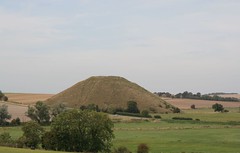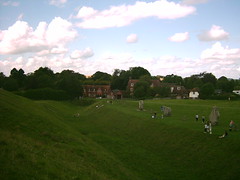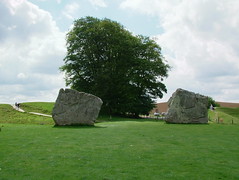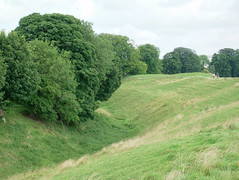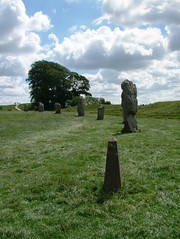
When I was growing up, we had a wonderful programme on every Friday evening, about country matters. It was called "Out of Town" and for years the music was Max Bygraves singing the song of that name. Then this changed, and the most wonderful classical guitar music became the theme ("
Recuerdos de la Alhambra". )
First of all a chap called Olly Kite was the presenter, but he died suddenly and the programme was taken over by Jack Hargreaves. Each week it would start with Jack in his workshop. There would be a little chat about a particular topic, and then you would go "out and about" with the camera, whilst Jack explained more about the subject. The love of his life was undoubtedly angling - but he made it interesting even for a teenage girl with no interest in fishing! However, he covered all country topics, and knew a lot about farming, and country ways. He would often end the programme with an unknown article from bygone days, and ask anyone who might know what it was to get in touch.
I met him once, at an auction in Dorchester. I was in the part selling items of horse tack. Jack was quiet and didn't mind me approaching him and telling him how much I enjoyed his programme, and asking what was he going to bid on? At that time he had a little white mule which he drove about the place, and he was looking for a browband for the mule. Not a whole bridle, not even a NEW browband, but one from an auction! He had Yorkshire roots , for all he had grown up on the outskirts of London, and I think his Yorkshire blood must have been to the fore that day!
There was another old countryman I loved to see on TV. This time he was like me, a proper "Hampshire Hog" - Norman Goodland. He lived around the Timsbury area of Hampshire, if my memory serves me well. I have a couple of his books here - "Down on the Farm" and "Country Craftiness". He had a keen ear for the local dialect - here is a short peace from a chapter " '
Angin' a geate":
'Angin' a geate? Ther' beant nwo 'hart' t' that as I can zee. 'Tis the knowin' ow' t' zet about 't. This yer's a gurt five-bar geate. This yer's the main-pwost: nine voot an' six inches long, nine inches square. Mun't be nwo narrier 'n that! 'E got t' be rounded at top luk, swo's t' keep out the weather. Ef un bean't rounded at top, un wun't least. And 'e got t' be woak. Ef un bean't woak vor a five-bar, thee's weaten' thy toime!
I was looking at the dialect poetry of Dorset's William Barnes this week, and thinking how much it was similar to the West Country dialects - especially Zummerzet (Somerset for Nancy & Co!). Yet, reading that bit from Norman Goodland, it would seem that Hampshire had a lot more in common with the West Country dialects than I realized. Here's an example of William Barnes' work. Girt is great; woak is oak; thik is this. Some of the words are still part of Dorset speech today (indeed I use them myself!)
THE GIRT WOAK TREE THAT'S IN THE DELL The girt woak tree that's in the dell !
There's noo tree I do love so well;
Vor times an' times when I wer young
I there've a-climb'd, an' there've a-zwung,
An' pick'd the eacorns green, a-shed
In wrestlen storms from his broad head,
An' down below's the cloty brook
Where I did vish with line an' hook,
An' beat, in playsome dips and zwims,
The foamy stream, wi' white-skinn'd lim's.
An' there my mother nimbly shot
Her knitten-needles, as she zot
At evenen down below the wide
Woak's head, wi' father at her zide.
An' I've a-played wi' many a bwoy,
That's now a man an' gone awoy;
Zoo I do like noo tree so well
'S the girt woak tree that's in the dell.
An' there, in leater years, I roved
Wi' thik poor maid I fondly lov'd,-
The maid too feair to die so soon,-
When evenen twilight, or the moon,
Cast light enough 'ithin the pleace
To show the smiles upon her feace,
Wi' eyes so clear's the glassy pool,
An' lips an' cheaks so soft as wool.
There han' in han', wi' bosoms warm
Wi' love that burned but thought noo harm,
Below the wide-bough's tree we past
The happy hours that went too vast;
An' though she'll never be my wife,
She's still my leaden star o' life.
She's gone: an' she've a-left to me
Her token in the girt woak tree;
Zoo I do love noo tree so well
'S the girt woak tree that's in the dell.
An' oh ! mid never ax nor hook
Be brought to spweil his steately look;
Nor ever roun' his ribby zides
Mid cattle rub ther heairy hides;
Nor pigs rout up his turf, but keep
His lwonesome sheade vor harmless sheep;
An' let en grow, an' let en spread,
An' let en live when I be dead.
But oh! if men should come an' vell
The girt woak tree that's in the dell,
An' build his planks 'ithin the zide
O' zome girt ship to plough the tide,
Then, life or death ! I'd goo to sea,
A-sailen wi' the girt woak tree
An' I upon his planks would stand,
An' die a-fighten vor the land,-
The land so dear,-the land so free,-
The land that bore the girt woak tree;
Vor I do love noo tree so well
'S the girt woak tree that's in the dell.








